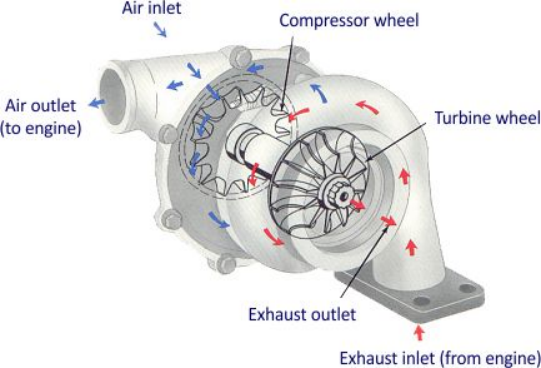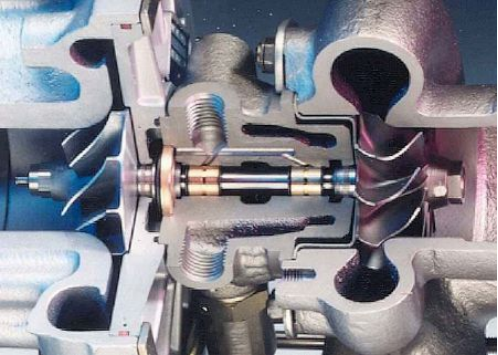0086-415-3512089
A turbocharger consists of a compressor wheel and exhaust gas turbine wheel coupled together by a solid shaft and that is used to boost the intake air pressure of an internal combustion engine. The exhaust gas turbine extracts energy from the exhaust gas and uses it to drive the compressor and overcome friction. In most automotive-type applications, both the compressor and turbine wheel are of the radial flow type. Some applications, such as medium- and low- speed diesel engines, can use an axial flow turbine wheel instead of a radial flow turbine. The flow of gases through a typical turbocharger with radial flow compressor and turbine wheels is shown in Figure 1

Figure 1. Turbocharger construction and flow of gases
Center-Housing. The turbine-compressor common shaft is supported by a bearing system in the center housing (bearing housing) located between the compressor and turbine (Figure 2). The shaft wheel assembly (SWA) refers to the shaft with the compressor and turbine wheels attached, i.e., the rotating assembly. The center housing rotating assembly (CHRA) refers to SWA installed in the center-housing but without the compressor and turbine housings. The center housing is commonly cast from gray cast iron, but aluminum can also be used in some applications. Seals help keep oil from passing through to the compressor and turbine. Turbochargers for high exhaust gas temperature applications, such as spark ignition engines, can also incorporate cooling passages in the center housing.

Figure 2.Sectional view of turbocharger
Sectional view of an exhaust gas turbocharger for a gasoline engine showing compressor wheel (left) and turbine wheel (right). The bearing system consists of a thrust bearing and two fully floating journal bearings. Note the cooling passages.
Bearings. The turbocharger bearing system appears simple in design, but it plays a key role in a number of critical functions. Some of the more important ones include: the control of radial and axial motion of the shaft and wheels and the minimization of friction losses in the bearing system. Bearing systems have received considerable attention because of their influence on turbocharger friction and its impact on engine fuel efficiency.
With the exception of some large turbochargers for low-speed engines, the bearings that support the shaft are usually located between the wheels in an overhung position. This flexible rotor design ensures that the turbocharger will operate above its first, and possibly second, critical speeds and can therefore be subject to rotor dynamic conditions such as whirl and synchronous vibration.
Seals. Seals are located at both ends of the bearing housing. These seals represent a difficult design problem due to the need to keep frictional losses low, the relatively large movements of the shaft due to bearing clearance and adverse pressure gradients under some conditions.
These seals primarily serve to keep intake air and exhaust gas out of the center housing. The pressures in the intake and exhaust systems are normally higher than in the turbocharger’s center housing which is typically at the pressure of the engine crankcase. As such, they would primarily be designed to seal the center housing when the pressure in the center housing is lower than in the intake and exhaust systems. These seals are not intended to be the primary means of preventing oil from escaping from the center housing into the exhaust and air systems. Oil is usually prevented from contacting these seals by other means such as oil deflectors and rotating flingers.
Turbocharger seals are different from the soft lip seals normally found in rotating equipment operating at much lower speeds and temperatures. The piston ring type seal is one type that is often used. It consists of a metal ring, similar in appearance to a piston ring. The seal remains stationary when the shaft rotates. Labyrinth-type seals are another type sometimes used. Generally, turbocharger shaft seals will not prevent oil leakage if the pressure differential reverses such that the pressure in the center housing is higher than in the intake or exhaust systems.

Fengcheng,Liaoning,P.R China









